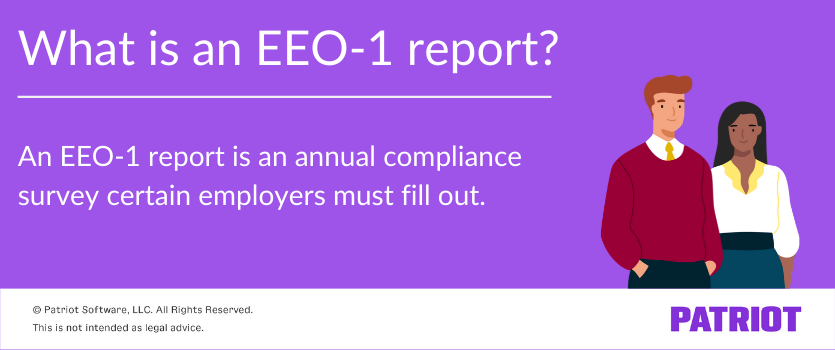When your business grows, you may need to hire additional employees. But, hiring more employees comes with additional responsibilities. Depending on the number of employees you have and some other factors, you may be responsible for filing an EEO-1 report. So … what is EEO-1, anyways?
What is an EEO-1 report?
The EEO-1 report (equal employment opportunity), also known as Standard Form 100, is a mandatory annual data collection that requires certain employers to submit workforce demographic data to the EEOC.
This reporting was enacted through Title VII of the Civil Rights Act of 1964. The act requires certain employers to report the racial/ethnic and sex composition of their workforce. All qualifying employers in public and private sectors must comply with Title VII of the Civil Rights Act of 1964 to be considered an equal opportunity employer.
In recent years, the standard EEO-1 Component 1 reporting is required. “Component 1” is a specific term used by the EEOC to refer to a particular set of workforce demographic data:
- Race/ethnicity
- Sex
- Job category
The report helps the EEOC enforce federal laws prohibiting employment discrimination and supports employers in self-assessing their diversity practices.

Who is required to file an EEO-1 report?
Certain private employers and all federal contractors must file an EEO-1 report.
Private employers
According to the U.S. Equal Employment Opportunity Commission, private employers must file Standard Form 100 if all of the following are true:
- Your business is located in one or more of the 50 U.S. states or the District of Columbia
- Your business is subject to Title VII of the Civil Rights Act of 1964
- Your business has either of the following workforce size thresholds:
- 100 or more employees
(Note: This excludes certain organizations such as state/local governments, public school systems, higher education institutions, American Indian or Alaska Native tribes, and tax-exempt private membership clubs other than labor organizations)
—OR— - Fewer than 100 employees but is owned, affiliated with, or controlled by a company with more than 100 employees overall
- 100 or more employees
Federal contractors
According to the Department of Labor, all federal contractors must also fill out an equal employment opportunity compliance report if all of the following conditions are met:
- You have 50 or more employees
- You are prime contractors or first-tier subcontractors,
—AND at least one of the following is true:- You have a federal government contract, subcontract, or purchase order amounting to $50,000 or more
—OR— - You are a financial institution that:
- Serves as a depository of government funds in any amount
- Acts as an issuing and paying agent for U.S. Savings Bonds and Notes
- You have a federal government contract, subcontract, or purchase order amounting to $50,000 or more
Who Is exempt from EEO-1 Reporting?
You may be wondering, What organizations or employers don’t have to file an EEO-1 report? Good question…
- Private employers with 1 – 99 employees are not required to file EEO-1 data
- Federal contractors with 1 – 49 employees
- Are exempt under regulation 41 CFR 60-1.5, –even if you have 50 or more employees
How do you fill out an EEO-1 report?
To complete your EEO-1 Component 1 report, you’ll need to gather and enter the following company and employee information:
Company Details
- Number of reports being filed by the company
- Company information (e.g., business name, address, etc.)
- Employer Identification Number (EIN)
- Whether your company is a single-establishment or multi-establishment employer
- Contact information (name, title, phone number, email) of the certifying official—typically someone in HR, compliance, executive leadership, or the business owner.
Reporting Period Dates
- The workforce snapshot period– any pay period between October 1 – December 31 of the reporting year.
- The report date
Employee Demographic Data
You’ll need a list of all employees in your EEO-1 report. This includes both part-time and full-time employees in the reporting snapshot.
- Total number of employees during the snapshot period, broken down by:
- Job category
- Sex
- Race/ethnicity
- Previous year’s total employee count
Additional data requirements for multi-establishment employers
If you’re a multi-establishment employer, also submit these types of EEO-1 data reports:
- Consolidated Report (Type 2, Required): All employees of the company, categorized by race, gender, and job category.
- Headquarters Report (Type 3, Required): Employees working at the main office site of the company and those employees who work from home and report to the corporate office. A separate EEO-1 report for the headquarters establishment is required even if there are fewer than 50 employees working at the headquarters establishment.
- Establishment Report (Type 4, Required): A separate EEO-1 Type 4 report must be submitted for each physical establishment with 50 or more employees.
Multi-establishment employers with fewer than 50 employees must submit one of the following:
- Establishment Report (Type 8): Submit a separate EEO-1 report for each establishment employing fewer than 50 employees.
How do you file an EEO-1 report?
Employers must file the EEO-1 Component 1 data electronically through the EEO-1 Online Filing System. Before submitting your data to the EEOC:
- Review all the demographic data entries for accuracy
- Ensure the workforce snapshot date (from October–December) is correctly applied
- Click “Certify Report” — a required final step that officially submits the report confirming the accuracy and completeness of the information. If this step is skipped, the EEOC does not consider the report filed.
What is the deadline for EEO-1 reporting?
EEO-1 report deadlines have varied in recent years. Employers should regularly check the EEOC’s official website for updates. When the EEOC data collection period opens, the dates will be listed for the specific filing deadline for that year.
To ensure you stay compliant, keep up with reporting requirements and deadlines. Failing to stay up-to-date with EEO-1 rules and filing an incomplete or inaccurate report can result in fines and other consequences for your business.
Contact the EEOC with any questions about the EEO-1 reporting process.
Want to make EEO-1 reporting even easier? With Patriot’s HR software, you can track employee demographic information and run a Demographics Report to get the data you need to enter on the EEO-1 report. Start your free trial and experience our payroll software and HR software add-on today!
This article has been updated from its original publication date of February 23, 2015.
This is not intended as legal advice; for more information, please click here.



